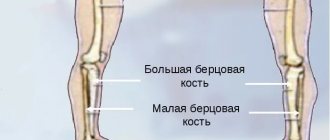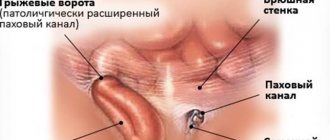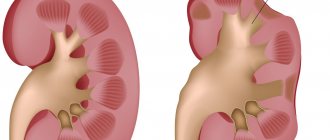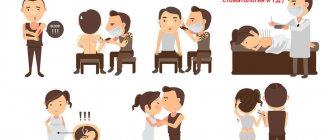Published: 10/05/2021 13:40:00 Updated: 10/05/2021
Appendicitis is an acute inflammation of the cecum, affecting its vermiform appendix (appendix). This anatomical organ is not a rudiment, as previously thought. It has an immune function and is involved in the formation of intestinal microbiota, so the recent “fashion” for preventive appendectomy had no real clinical basis. However, if the appendix is inflamed, it must be removed surgically.
The disease is infectious in origin, develops quickly and requires emergency surgical care. Acute appendicitis is in the group of 7 nosological forms, combined into the “Acute abdomen” symptom complex, occupying a share of 27.7% in its structure [1]. The incidence of acute appendicitis in Europe is 12 cases per 100 people, more than 220,000 operations are performed annually in Russia, and the mortality rate is 0.13% [2].
Appendicitis can happen to a person of any age and gender, previously predominantly in those aged 10 to 19 years, but in recent years the incidence of appendicitis has increased in the age group from 30 to 69 years [1].
Acute appendicitis can be catarrhal (simple, without complications), gangrenous, phlegmonous, with empyema of the appendix, primary or secondary.
Symptoms of appendicitis
Classic signs of acute appendicitis:
- vomiting and nausea, mainly in the first hours of illness;
- stomach ache;
- dry mouth, coated tongue;
- lack of appetite;
- adopting the fetal position (curling up on the sore side);
- lag of the right side of the abdomen when breathing;
- pain in the right lower abdomen when lifting a straight leg up from a position on the left side;
- pain when pressing between the navel and the ilium;
- pain when releasing the palm after pressing on the abdomen.
The main symptom of appendicitis is pain in the right lower abdomen, suddenly appearing, aching, constant, at first of uncertain localization, but then concentrated near the navel on the right.
Which side of appendicitis gives pain depends on the anatomical features of the location of the appendix. This could be the following localization:
- down to the right of the navel;
- right hypochondrium;
- closer to the midline to the right of the navel;
- in the lower right part of the abdomen, closer to the bladder;
- sometimes the pain radiates to the right hip joint and right thigh;
- Sometimes with appendicitis it hurts to the left of the navel or in the stomach area.
With appendicitis in pregnant women in the later stages, the pain is localized in the right side or right hypochondrium, since the pregnant uterus displaces all organs.
The greatest problem is represented by atypical forms of appendicitis. About a third of cases occur without traditional signs of appendicitis, masquerading as other diseases, which is especially important for women of fertile age. Urinary disorders, gallbladder diseases, diarrhea, very high body temperature, and gynecological diseases may occur.
Complications of acute appendicitis:
- rupture of the appendix;
- appendicular infiltrate or abscess (suppuration of the appendix);
- retroperitoneal phlegmon (suppuration in the retroperitoneal space);
- peritonitis (inflammation of the peritoneum);
- pylephlebitis (inflammation of the veins of the cecum);
- sepsis (blood poisoning).
Children and elderly people with chronic diseases of the cardiovascular system, diabetes mellitus, and neoplasms die from appendicitis.
Lack of treatment also leads to death; appendicitis cannot go away on its own.
Delayed presentation also increases the risk of death. In St. Petersburg, for example, only 67% of patients with appendicitis see a doctor on the first day [1].
Are your teeth to blame?
Experts do not agree on the exact causes of appendicitis. However, risk groups have been identified.
For example, people suffering from diseases such as chronic tonsillitis, pneumonia, persistent colds, diseases of the gastrointestinal tract, caries. As a result of these diseases, infections penetrate through the bloodstream into the appendix and provoke an inflammatory process there. So healthy teeth are the key to a healthy appendix.
There is also a stress theory. It is based on the fact that as a result of excitement in a person, a sharp narrowing of the blood vessels occurs and this leads to sudden bleeding of the appendix and the development of its inflammation.
But most often the occurrence of appendicitis is explained by blockage of the junction of the colon and the appendix, which often happens with constipation and chronic colitis.
Appendicitis in children
The highest incidence occurs between the ages of 9 and 12 years, and in general, acute appendicitis occurs in 3-6 out of 1000 children [3].
Appendicitis in children over 3 years of age occurs almost the same as in adults. Young patients are characterized by:
- long-term localization of pain in the epigastrium, then throughout all parts of the abdomen;
- constipation or repeated diarrhea;
- repeated vomiting;
- restlessness, crying, lack of appetite;
- fever up to 39 °C;
- slight bloating, constant tension in the muscles of the abdominal wall.
In children, especially in the first three years of life, inflammation develops faster and complications are more frequent.
Blind but dangerous
The appendix is a short and thin blind vermiform appendix 7-10 cm long, located at the end of the cecum (the initial part of the large intestine). Like any part of the intestine, the appendix produces intestinal juice, but so little that it does not play a special role in digestion. Therefore, for a long time it was considered a “mistake of nature” and was removed by the patient at the first opportunity. But recently, scientists discovered lymphoid cells in the caecum, the same as in human tonsils. And since these cells have the properties to protect the body from infections, the assumption was born that the appendix is part of the immune system.
However, the number of protective cells in it, as it turned out, is very insignificant and cannot have a strong effect on the immune system. So most experts are still confident that there is no benefit from the appendix, but the harm in case of its inflammation can be significant: acute appendicitis not diagnosed in time can cost not only health, but also life.
Diagnosis of appendicitis
- First of all, a consultation with a surgeon is required in the first hour of hospitalization. Special diagnostic scales are used (AAS, Alvarado, RIPASA).
- If you have appendicitis in women, you need to consult a gynecologist.
- For dysuria, consult a urologist.
- Ultrasound of the abdominal cavity.
- CT scan of the abdominal cavity (pregnant women with appendicitis undergo ultrasound or MRI instead of CT).
- Diagnostic laparoscopy is a minimally invasive intervention in which the abdominal cavity is examined through a small incision with a laparoscope. Having detected signs of appendicitis, they proceed to laparoscopic appendectomy.
Tests for appendicitis
- General clinical blood test (shows signs of inflammation in the form of increased ESR, C-reactive protein, leukocytosis, neutrophilia).
- General urine test (for differential diagnosis).
- Determination of alpha-amylase in urine (including pancreatic) - this enzyme allows you to identify inflammation of the abdominal organs.
- Culture of abdominal exudate for sensitivity to antibiotics.
- Histological examination of the appendix.
The material for the last two studies is taken during the operation.
Disease prevention
The appendix is part of the digestive system, so it is important to monitor your diet to ensure it is clean:
- Enrich the menu with fiber - food with coarse fibers: mushrooms, algae, fresh vegetables, bran and legumes. In addition, herbs will help - do not underestimate the importance of eating greens in cleansing the intestines, destroying pathogenic bacteria and strengthening the immune system.
- Doctors advise not to eat seeds and berries with small seeds, so as not to provoke pathological processes in the digestive system.
Advantages
Treatment of appendicitis
In the vast majority of cases, acute appendicitis requires surgery.
Only with appendiceal infiltrate and sometimes during pregnancy do they begin with conservative therapy, that is, intravenous antibiotics (amoxiclav or cefotaxime with metronidazole, tigecycline, ertapenem) for 2 days. Before the operation, medication preparation is carried out (water and electrolyte disturbances are eliminated, antibiotic therapy is administered, intoxication and pain are relieved, and thrombosis is prevented).
Removal of appendicitis - appendectomy - is performed as an abdominal or laparoscopic operation.
The risk of blood clots increases with:
- heavy weight;
- over 50 years of age;
- oncological diseases;
- history of heart attack and stroke;
- varicose veins;
- SLE and erythremia;
- postpartum period;
- injuries;
- taking hormonal contraceptives.
The operation is performed under general anesthesia or conduction anesthesia.
In case of a complicated course, antibiotics are also prescribed in the postoperative period; in case of catarrhal appendicitis, this is not required. On the first day, only liquid pureed food is given. The patient is discharged from the hospital on the 3-4th day, and the sutures are removed on the 5-8th day.
Recommendations
If you experience abdominal pain, seek medical attention immediately. If pain occurs at night or on weekends, call an ambulance. Do not take any painkillers other than no-shpa, as this can erase the clinical picture of an acute disease, which leads to late diagnosis and complications.
Remember, the sooner you contact a specialist, the lower the risk of complications. If treated in a timely manner, surgical treatment is limited to appendectomy only (removal of the appendix).
If you have a choice, then contact a medical institution that can perform a laparoscopic appendectomy. But even if the clinic does not have equipment for laparoscopic operations, an experienced surgeon can perform an appendectomy from a small incision (3–4 cm) followed by a cosmetic intradermal suture.
It happens that in the presence of a clinical picture of acute appendicitis, entering the abdomen, the surgeon sees an unchanged appendix. In such cases, he must check the entire abdominal cavity, identify the cause of the disease and eliminate it. That is why an experienced, highly qualified surgeon is needed.
Recovery after appendectomy
With uncomplicated appendicitis, recovery occurs quickly; complications require longer hospitalization and a longer period of postoperative rehabilitation.
Factors contributing to early recovery: early diagnosis and timely surgery, absence of concomitant diseases, young age, absence of complications.
Risk factors: late hospitalization, obesity, elderly and senile age, peritonitis, sepsis, multiple concomitant diseases.
Within a month after removal of appendicitis you should:
- limit physical activity, especially stress on the abdominal muscles;
- follow a diet that excludes vegetables, fruits, essential oils, smoked meats, animal fats, fried, spicy foods, foods rich in purines and cholesterol (red meat, lard, jelly, strong broths, packaged soups, smoked meats, fatty fish, legumes, canned food) , raspberries, figs, grapes, eggs, cottage cheese, butter, margarine, fatty dairy products.
With the modern level of development of medicine, appendicitis is treatable, but much depends on timely access to a doctor and correct behavior after surgery.
Features of signs in old and senile age
In older people, the course of appendicitis depends on:
- from reducing the reserve capacity of the immune system to protect against infection;
- the presence of concomitant vascular damage by the atherosclerotic process;
- chronic diseases.
The onset of the disease is less acute than in young people, the pain is moderate even in destructive forms. In patients:
- nausea, vomiting, constipation with difficult passage of gases are observed;
- the temperature rarely rises;
- tension in the abdominal muscles is weak or absent;
- The blood test showed moderate leukocytosis without a shift in the formula.
Bibliography
- Barsukova, I.M. Acute appendicitis: history and modern organization of medical care// I.M. Barsukova, M.V. Gavshchuk, A.P. Krivov. - text: direct // Scientific notes of St. Petersburg State Medical University named after. I. P. Pavlova, 2021.- No. 3 – P. 43-49, DOI: 10.24884/1607-4181-2018-25-3-43-49.
- Clinical guidelines “Acute appendicitis in adults”, 2021, Developers: All-Russian public association “Russian Society of Surgeons”, All-Russian public organization “Russian Society of Endoscopic Surgeons”. - Text: electronic. - URL: (access date: 09/29/2021).
- Draft clinical guidelines “Acute appendicitis in children”, 2016. Developer: Russian Association of Pediatric Surgeons, -Text: electronic.- URL: (access date: 09.29.2021).
Author:
Pugonina Tatyana Alekseevna, Therapist
Why should you contact the Mama Papa Ya clinic?
The diagnostic service for appendicitis is provided in Moscow, in family clinics of the “Mom, Dad, Me” network, where experienced, highly qualified specialists work. The most complex problems are successfully solved here. The institutions have installed the most modern equipment to effectively provide services at an affordable price and have created comfortable conditions to provide patients with a positive psychological attitude, a sense of protection and safety.
Reviews
Good clinic, good doctor!
Raisa Vasilievna can clearly and clearly explain what the problem is. If something is wrong, she speaks about everything directly, not in a veiled way, as other doctors sometimes do. I don’t regret that I ended up with her. Anna
I would like to express my gratitude to the staff of the clinic: Mom, Dad, and me. The clinic has a very friendly atmosphere, a very friendly and cheerful team and highly qualified specialists. Thank you very much! I wish your clinic prosperity.
Anonymous user
Today I had a mole removed on my face from dermatologist I.A. Kodareva. The doctor is very neat! Correct! Thanks a lot! Administrator Yulia Borshchevskaya is friendly and accurately fulfills her duties.
Belova E.M.
Today I was treated at the clinic, I was satisfied with the staff, as well as the gynecologist. Everyone treats patients with respect and attention. Many thanks to them and continued prosperity.
Anonymous user
The Mama Papa Ya clinic in Lyubertsy is very good. The team is friendly and responsive. I recommend this clinic to all my friends. Thanks to all doctors and administrators. I wish the clinic prosperity and many adequate clients.
Iratyev V.V.
We visited the “Mama Papa Ya” Clinic with our child. A consultation with a pediatric cardiologist was needed. I liked the clinic. Good service, doctors. There was no queue, everything was the same price.
Evgeniya
I liked the first visit. They examined me carefully, prescribed additional examinations, and gave me good recommendations. I will continue treatment further; I liked the conditions at the clinic.
Christina
The doctor carefully examined my husband, prescribed an ECG and made a preliminary diagnosis. She gave recommendations on our situation and ordered additional examination. No comments so far. Financial agreements have been met.
Marina Petrovna
I really liked the clinic. Helpful staff. I had an appointment with gynecologist E.A. Mikhailova. I was satisfied, there are more such doctors. Thank you!!!
Olga










